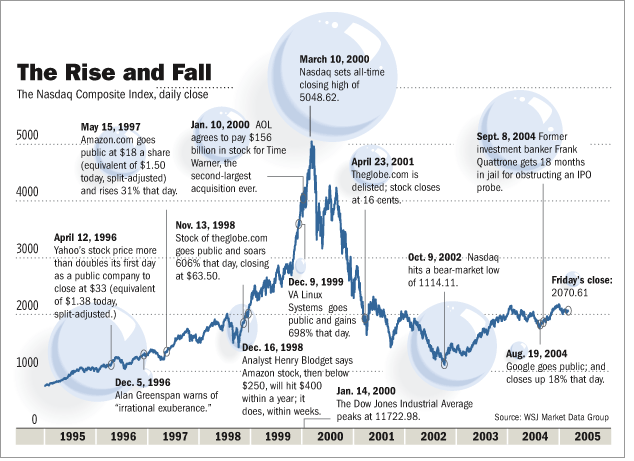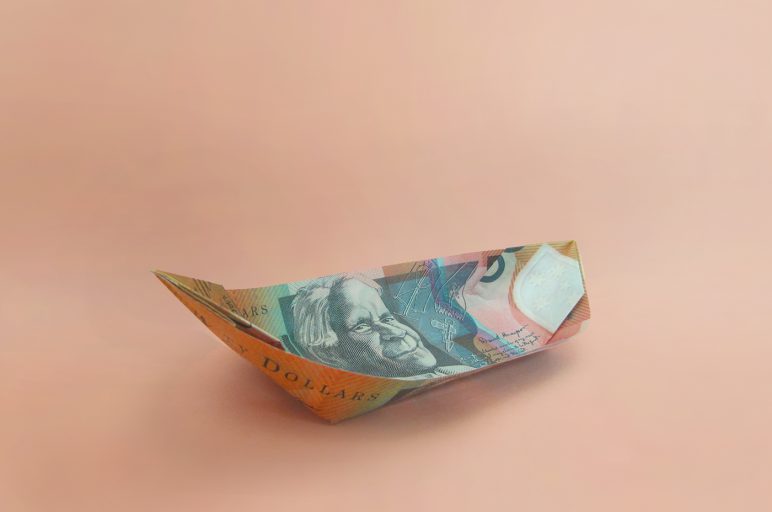They say that history doesn’t repeat, but it rhymes. It feels that way now in the share market.
The first share market bubble I experienced was the technology bubble (also known as the dot-com bubble and tech bubble) which played out in 1999 and 2000. Across two years the tech-heavy NASDAQ index rose by 300 per cent.
In the last six months alone from September 1999 to March 2000 the index doubled! From its high point in March 2000 it fell by 80 per cent. This is still the fastest market rise and steepest market fall I’ve ever experienced.

Source: WSJ
As a young trader, one of the best lessons I learned from that experience is that markets can always go further than you expect – both to the upside and downside. I also discovered that markets have a way of humbling everyone at some point.
This is one of the reasons why at Stockspot we advise clients to diversify broadly, rebalance when markets have extreme moves and resist the temptation to try and outsmart the millions of other investors and speculators out there.
Fast forward to 2022
Fast forward to early 2022 and the current market conditions feel similar to 1999.
- In 1999 the fear of Y2K was driving huge capital investment into tech companies. Today, it’s COVID-19 which has increased our reliance on tech companies for home, work and life.
- In 1999 it was Web 1.0 tech leaders AOL and Yahoo driving the market higher. Today it’s Web 2.0 giants like Meta and Alphabet with a stranglehold over consumer attention and online advertisers.
- In 1999 a new generation of traders (including me) were discovering markets with E*TRADE. Today it’s Robinhood, Coinbase and a litany of new trading platforms encouraging Millennials and Gen Z into speculation and self-directed investing.
- The speculative gold rush of dot-com IPOs and domain names in 1999 has been replaced by the Wild West of cryptocurrencies and DeFi (Decentralised finance).
- And just like in late 1999, ‘value’ fund managers have suffered a 10 year period of underperformance. Some have shut down, others will take a long time to claw back years of underperformance.
Why we may not have hit the final peak in tech speculation
In 2021 we saw bitcoin go berserk, Robinhood and GameStop capture news headlines around the world and Cathie Wood’s ARK Innovation ETF (ARKK) gather more assets than Blackrock ETFs.
A lot of the heat has since come out of the market. GameStop has fallen 80% from it’s high. Robinhood’s share price is down 85% and Cathie Wood’s ARKK innovation fund is down 55%.
Despite these falls, what if the final peak in tech stock speculation actually happens in 2022?
What you could expect to see near the peak of a tech speculative bubble
- ‘Value’ focused fund managers adding shares like Alphabet, Apple and Tesla to their portfolios to help them address the underweight positions that have led them to lag the market for 10 years!
- A crescendo of tech-focused funds and ETFs, including more launched by traditional ‘value’ managers. In 1999/2000 there was the ANZ Global Technology Fund, the BT Technology Fund and AMP Capital Global Technology Fund.
- A final steep move upwards in ‘speculative’ tech including:
- A new price high in bitcoin and speculative mania in other cryptocurrencies
- A return of the meme stocks on Reddit and a resurgence in speculation on retail trading platforms like Coinbase and Robinhood.
What the 2000 tech bubble can teach diversified investors
The Stockspot portfolios have an allocation to U.S. tech companies via the IOO ETF but are also spread across different countries, sectors and asset classes. If the Stockspot portfolios existed in their current allocations back in the late 90s and early 2000s, this is what the performance would have looked like across the decade starting 1997, including the 1999/2000 tech bubble and bust.
| Calendar Year Total Returns | Topaz (Aggressive growth) | Turquoise (Balanced) |
| 1997 | 15.8% | 15.6% |
| 1998 | 4.1% | 4.8% |
| 1999 | 20.7% | 15.6% |
| 2000 | 0.9% | 2.7% |
| 2001 | 7.3% | 6.9% |
| 2002 | -8.2% | -4.6% |
| 2003 | 8.8% | 6.9% |
| 2004 | 18.5% | 15.2% |
| 2005 | 25.0% | 21.2% |
| 2006 | 19.8% | 16.0% |
Be consistent with your approach
Thanks to broad diversification, the 2000 tech boom and bust would have been unnoticeable for Stockspot diversified investors. Over the 10 years there would have been just a single negative year in 2002.
At Stockspot we do not make bets about whether the tech sector is over or undervalued. We certainly do not take bets on value shares, growth shares or the latest market fad. Instead, we ensure that our portfolios are sufficiently diversified to capture the groundswell of the ever evolving movements in the economy.
That’s why I believe it pays to stay diversified, keep costs low, and give yourself the opportunity to rebalance when markets get extreme. Above all, be consistent with your approach.




